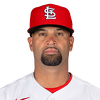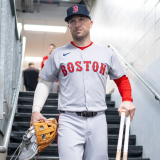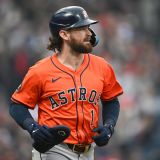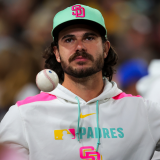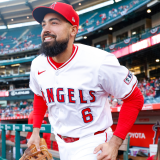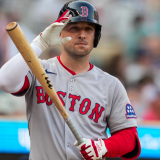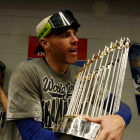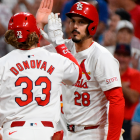Keri the 10: Pitchers can hit, the Red Sox corners stink and more MLB observations
Introducing Jonah Keri's new weekly feature with observations from around the week in MLB

For all of the internet’s flaws, we can always rely on it to dazzle us with three favorite pastimes: Sports, lists and terrible puns.
It’s in that spirit that we introduce “Keri The 10”. Every Friday, I’ll empty my MLB notebook with 10 stories, trends and tidbits of fun and weirdness for your reading pleasure. You’ll laugh, you’ll cry, hell, you might even use your own name for a self-aggrandizing play on words from 10 years ago!
Let’s dive into all the latest and greatest from the first week of the MLB season:
1. Pitchers’ hitting could become more significant
There’s nothing managers love more than security blankets. Knowing that there’s a backup plan to a backup plan to a backup plan helps ensure that a skipper avoids looking stupid. That’s why we’re seeing some teams moving to 13-man pitching staffs. That way, in those once-in-a-blue-moon occasions in which a game goes 15 innings, managers don’t have to tap their backup second baseman to come in and pitch.
Those bloated pitching staffs lead to short benches. And those short benches are prompting managers to deploy pitchers as pinch-hitters more and more often. The strategy makes some modicum of sense (assuming you can get past the silliness of carrying multiple mopup men who are rarely needed and aren’t actually good): If it’s the fifth inning, you’re carrying a backup catcher and a utility infielder and only have one legitimate bat on your bench, saving him for a bigger spot later in the game could be the right call.
The strategy worked perfectly this week for the Reds. Locked in a 4-4 tie with the Phillies in the sixth inning Thursday, Reds manager Bryan Price summoned relief pitcher Michael Lorenzen to pinch-hit. The result? Yardwork.
We know about the perils of overvaluing small sample size events, and this was the first regular-season pinch-hit home run by a major-league pitcher in eight years. But other events are afoot. We have Christian Bethancourt becoming a two-way threat for the Padres as a catcher who has taken up pitching, offering San Diego the equivalent of an extra man on the roster. We have Madison Bumgarner becoming the first pitcher ever to blast two home runs on Opening Day, building on his power-hitting legend.
And here’s one more thing: If everyone and their dog is figuring out that you can hit more home runs if you just try to do so, and pitchers are unlikely to hit for a high average or get on base much anyway, maybe we see more managers tapping hurlers to grab a stick, close their eyes and swing for the moon.
2. The Mets really need Matt Harvey to be Matt Harvey
Steven Matz has a strained flexor tendon in his pitching elbow and has been shut down for several weeks before he can even begin to think about throwing again. Seth Lugo has a partial tear of his UCL, and might need Tommy John surgery. Zack Wheeler hasn’t pitched in a major league game since 2014 as he tries to return from Tommy John surgery himself. A suddenly overflowing Mets rotation now finds itself scrambling for healthy arms.
Matt Harvey could be just the salve the Mets need. After a terrible season that ended with surgery to treat thoracic outlet syndrome, Harvey returned this spring carrying the hopes of tortured Mets fans with him. His first start in a game that counts Thursday could hardly have gone any better. In 6 2/3 innings, the Dark Knight allowed just two runs on three hits, striking out four and leading the Mets to a 6-2 victory and a series win over the Braves. He fired 68 of 96 pitches for strikes and averaged nearly 95 mph on his fastball.
With his teammates this banged up, 30 more starts like that one aren’t just a luxury. For a Mets team with playoff aspirations, they’re nearly a necessity.
3. Jameson Taillon is a human GIF machine
If the Pirates hope to make the postseason for the fourth time in five seasons, they too will need big performances from their starting rotation. In Pittsburgh’s case, the X-factor could be Jameson Taillon.
Like Harvey, Taillon is a Tommy John recovery case now trying to hold up and thrive over a full season of health. He was mostly excellent in half a season of work last year, posting a 5-to-1 strikeout-to-walk rate over 18 strong starts in his first big-league season. His first start of 2017 offered hope for more. Facing a loaded Red Sox lineup, Taillon twirled seven scoreless innings, striking out six. Watch him throw mid-to-high-90s heat with a hook from hell, and you wonder how anyone’s ever going to hit the guy.
When Jameson Taillon is pumping 96/97 with life and then can drop this hook, it's game over man. Game over. pic.twitter.com/ekFcbH50IO
— Pitcher List (@ThePitcherList) April 6, 2017
4. Trying to predict bullpens will mess with your head
Starting pitchers are throwing fewer innings than ever before, hiking the importance of a strong bullpen. The only problem is that, with rare exceptions, trying to predict which pens will thrive and which will fail is a fool’s errand.
Consider the San Francisco Giants. During their run of three World Series titles in five seasons from 2010-14, the bullpen’s core four of Sergio Romo, Santiago Casilla, Javier Lopez and Jeremy Affeldt played a pivotal role in the team’s success. As those four relievers aged, the Giants brought in other live arms to take their place in big spots. Those replacement have failed. Last season, San Francisco led the majors with 30 blown saves.
The Giants responded by giving veteran right-handed closer Mark Melancon a four-year deal that for a very short while ranked as the biggest contract ever handed to a reliever. On Opening Day, Melancon took the ball in the ninth inning, primed to log his first save as a Giant. Instead, he coughed up two runs and four hits, blowing the save and taking the loss. That wasn’t all. Casilla, one of the chief offenders in last year’s rocky pen, landed across the Bay in Oakland this offseason. In his first save chance as an Athletic, Casilla breezed through a fairly calm ninth inning, working around one walk to slam the door on the Angels.
Every year, bullpens like the Giants’, and many others, collapse out of nowhere. They do so for no apparent reason, other than the obvious: Relievers are almost always pitchers who weren’t good enough to hack it as starters, and when you start with lesser talent, bad things are bound to happen. If you’re a fan of one of the two or three teams that have somehow defied the odds and fielded great bullpens for several years running, count your lucky stars. Sooner or later, those guys will fail too.
5. The Red Sox might have the worst corner-infield combination in all of baseball
As it was in 2016, Boston figures to be a World Series contender. With a loaded group of position players led by MVP candidate Mookie Betts, and an already strong rotation getting even better with the addition of Chris Sale, the Red Sox are the favorites to win the AL East and hopefully fare better in October than they did last year.
The problem is their corner-infield tandem. When the Red Sox signed Pablo Sandoval to a five-year, $95 million contract after the 2014 season, they envisioned a two-way player who would live up to his reputation for offensive heroics in huge spots, with impressive agility afield to belie his hefty physique. Instead, he has been a disaster. In 2015, Sandoval was the worst position player in all of baseball by Wins Above Replacement. In 2016, he appeared in just three games before missing the rest of the season with a shoulder injury. He started 2017 by making errors in his first two games, going 1 for 8 with four strikeouts. It has now been three years since Sandoval has been an effective player, and drastic offseason weight loss might end up doing nothing other than making the panda look better in a Speedo.
First base might end up being better, but not much better. Spooked by a more punitive luxury tax, the Sox suddenly got thrifty over the winter. Rather than replace franchise player David Ortiz with a (surprisingly discounted) slugger like Edwin Encarnacion, Boston settled for Mitch Moreland as the cheap alternative. Small sample size aside (Moreland is 0 for 9 to start the season, with five strikeouts), Moreland doesn’t have a track record of consistent success. While his 2015 numbers were playable (.278/.330/.482, which even in hitter-friendly Texas worked out to 17 percent better than league average), his performances in 2013, an injury-shortened 2014, and 2016 point to one of the worst hitters in all of baseball at any power position who has received sustained playing time.
If you’re a fan of wagering, bet on the Sox to replace one or both of Sandoval and Moreland between now and the stretch run. On a roster otherwise brimming with talent, it’s hard to imagine two major albatrosses hitching a ride for too long.
WATCH: from this week’s Jonah Keri Show.
6. The Padres are going to be awful; but they might have a silver lining
San Diego opened the season in predictable fashion, dropping three out of four to the Dodgers and getting outscored 27-10 in the process. Most projection systems peg the Friars as the worst team in the National League, and maybe all of baseball. They are, by any measure, a really bad team.
So here’s a little piece of good news. Trolling the waters of the often ho-hum Rule 5 draft, the Padres snagged an intriguing young right-hander from the Brewers organization named Miguel Diaz. With little to lose, San Diego tossed the 22-year-old Diaz onto the Opening Day roster, hoping to find a little surprise.
So far, so great. In the first two appearances of his major-league career, Diaz has tossed 1 2/3 perfect innings with two strikeouts. Mopup work or not ... watch this 98 mph two-seamer do an impossible dance, and try not to get at least a little excited as a Padres fan.
Miguel Diaz brought the 🔥in his MLB debut. 👀 pic.twitter.com/cEpZWGsLpQ
— San Diego Padres (@Padres) April 4, 2017
7. Stephen Piscotty needs an exorcist
Hit by a pitch, hit by a throw sliding into second, hit by another throw sliding into home ... all in a span of a few minutes, in one inning. Don’t try this at home.
Stephen Piscotty with the most unlucky inning in baseball history. pic.twitter.com/AWJK1A44CD
— jacob (1-2) (@jacobgill13) April 5, 2017
WATCH: Breaking down Stephen Piscotty’s painful trip around the bases from this week’s Jonah Keri Show.
8. The Reds don’t have much, but they do have Brandon Finnegan
The 23-year-old lefty spun a masterpiece in his first start. In seven innings, Finnegan punched out nine and allowed just one hit and one walk, plus no runs.
This wasn’t just some random fluke either. As Nick Pollack, the mind behind the excellent site PitcherList.com explained, Finnegan made two adjustments that fueled his lights-out performance against the Phillies.
First, he changed his mechanics. Watch this GIF from September of last year:
... then compare it to this GIF from Wednesday’s season debut:
As Pollack explained:
“Notice how Finnegan comes off the rubber after he lands. In the first GIF, he’s falling heavily towards third base, which tells me he’s not getting all of his momentum toward the plate on delivery and pulling out a little more than he should. Compare that to the second GIF and you’ll see a much less exaggerated pull toward third base. This is due to his right arm not pulling back as violently as before, giving him a smoother release. This stabilized landing is a great indication that he’s driving more towards home plate and could explain his increase in velocity. Additionally, an improved amount of balance could be a major factor for better command.”
The second big change came in Finnegan’s pitch usage. Last season, the southpaw leaned heavily on a sinker, throwing it 53.7 percent of the time; he used his four-seam fastball far less frequently, just 11.3 percent of the time. On Wednesday, that trend flipped: 60.2 percent four-seam fastballs (56 of them in his start) vs. just eight percent sinker (four of them in the start). Add to that a full mile per hour on his fastball (from a little below 93 mph to just shy of 94 mph). And now the kicker: In 2016, Finnegan had 9.9 inches of vertical break on his four-seamer ... compared to a huge 13.6 inches of vertical break on the pitch Wednesday.
If Finnegan’s heater is going to be that fast, with that movement all year long, he could become a huge pain to hit. For a Reds team trying to build a pitching staff from almost nothing, that would be a huge boon to the team’s present -- and future.
9. The Royals might wish they still have Finnegan; what they could have is a huge dilemma on their hands
It’s tough for even the biggest revisionist Royals fans to lose sleep over the 2015 deadline deal that sent Finnegan (and more) to Cincinnati in exchange for Johnny Cueto, given that K.C. rolled to a World Series title that fall.
But the 2017 version of the Royals isn’t that loaded squad anymore. A once impenetrable bullpen is now vulnerable. A so-so rotation has grown progressively shakier, with only young lefty ace Danny Duffy representing a truly reliable option. Meanwhile, four core position players create a tough decision for GM Dayton Moore. With Eric Hosmer, Mike Moustakas, Lorenzo Cain and Alcides Escobar all eligible for free agency at season’s end, Moore must decide whether to cash in his key veterans for other (likely younger) talent, or try to ride it out and hope that Kansas City can again contend for a playoff spot.
An 0-3 start makes that goal of contention a little tougher. And if the Royals can’t improve on their .500 result from last season, July could create some tough decisions. If Kansas City does struggle and Moore decides to go into sell mode, the Royals would become the most influential team in baseball, capable of impacting multiple playoff races depending on how and where they scatter their players.
WATCH: Nerd Alert! The Royals missed out on Finnegan from this week’s Jonah Keri Show. Jonah goes in depth on Finnegan and why he will end up being ‘The One That Got Away’ for the end-of-an-era Royals team.
10. We are watching future Hall of Famers at work
From time to time, random, fun little questions pop into my mind. I’ll share these throughout the season, then throw the same question out to you.
Here’s this week’s brain-teaser: How many players currently playing will one day earn induction into the Baseball Hall of Fame?
Here’s my back-of-the-napkin Hall of Fame list, in no particular order:
Notable Omissions: Nolan Arenado, Max Scherzer, Chris Sale, David Price, CC Sabathia, Evan Longoria, Francisco Rodriguez
Who did I miss? Where did I go right, and wrong? Send a Tweet to @jonahkeri using hashtag #KeriThe10 to answer this question, or to submit questions for future No. 10s.
Until then, see you right back in this space next Friday!
































